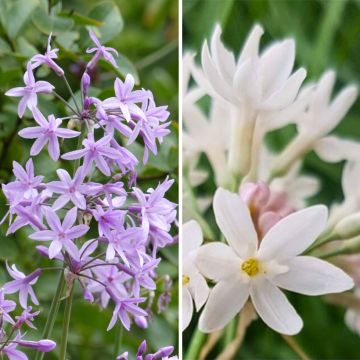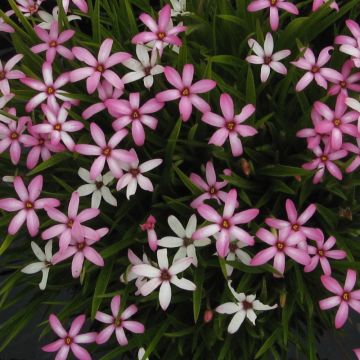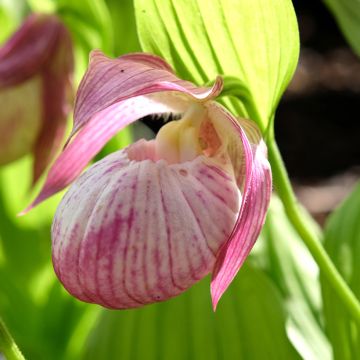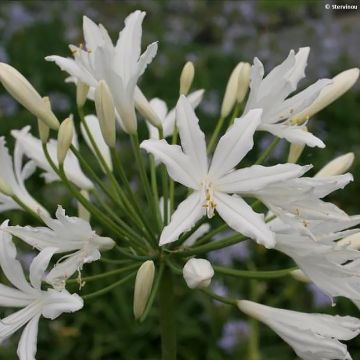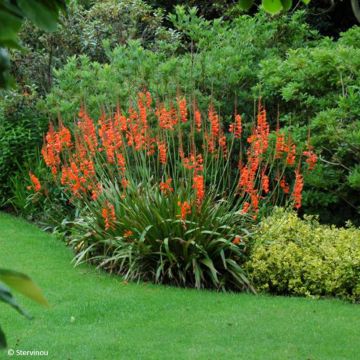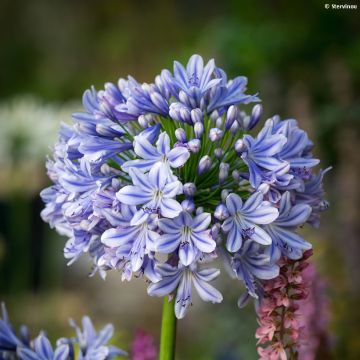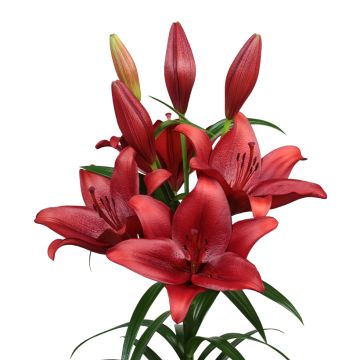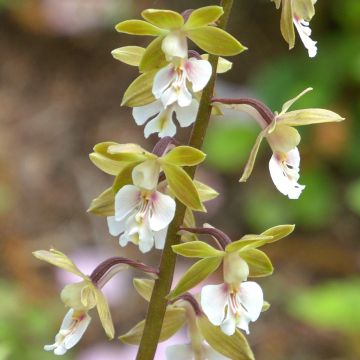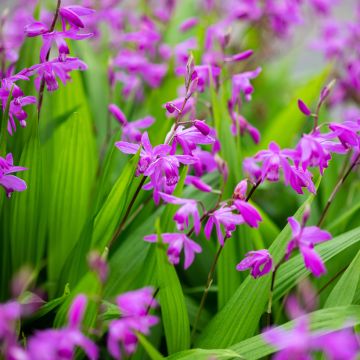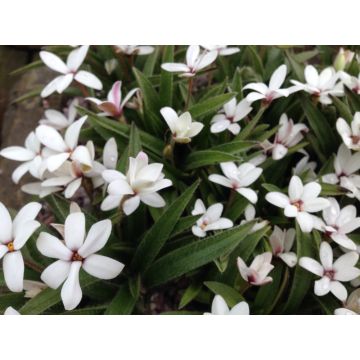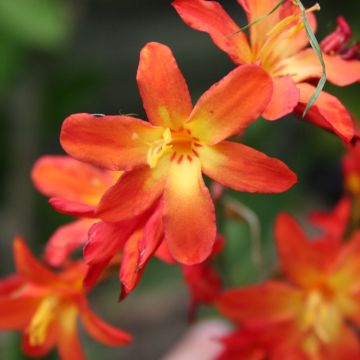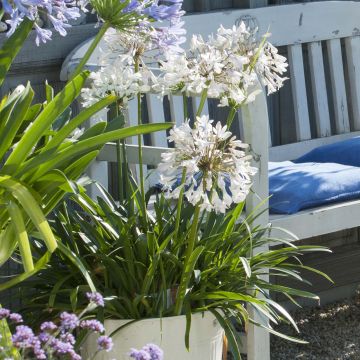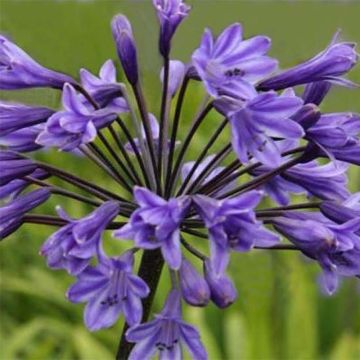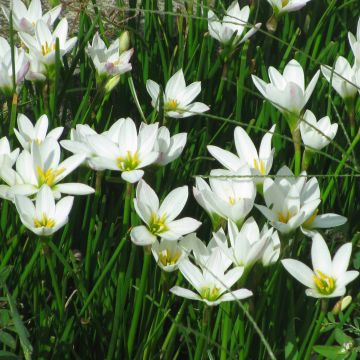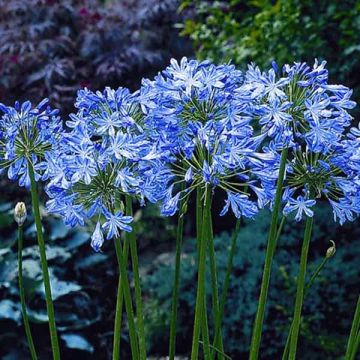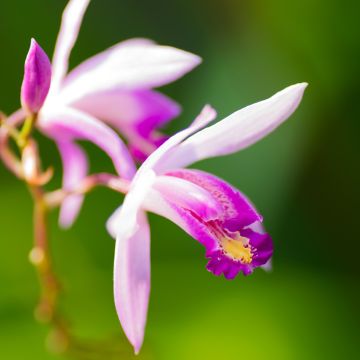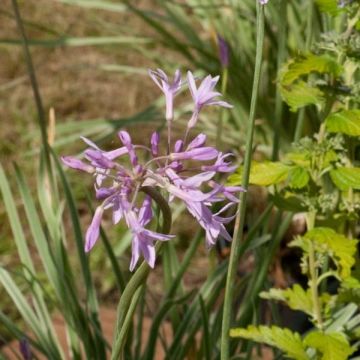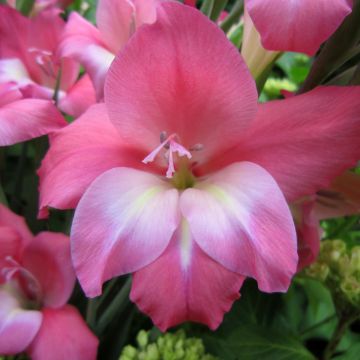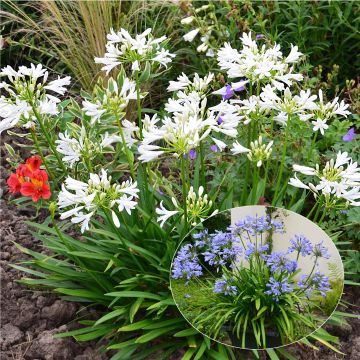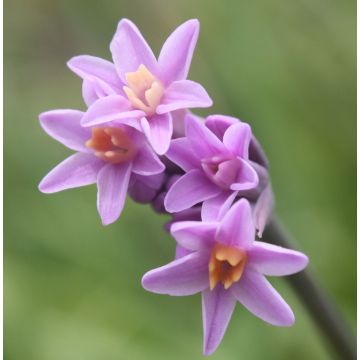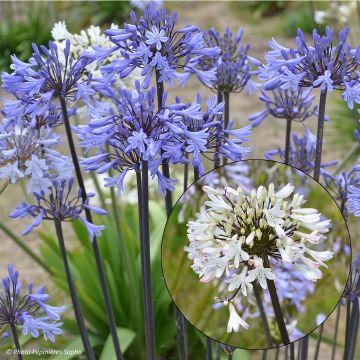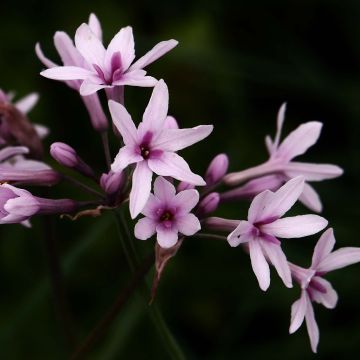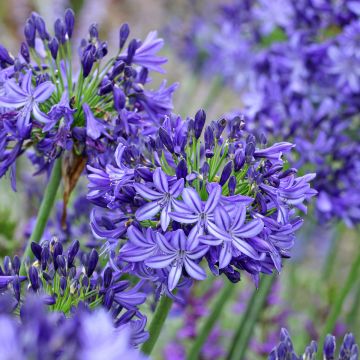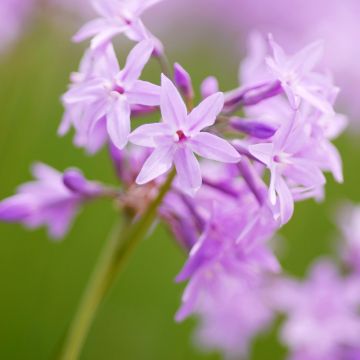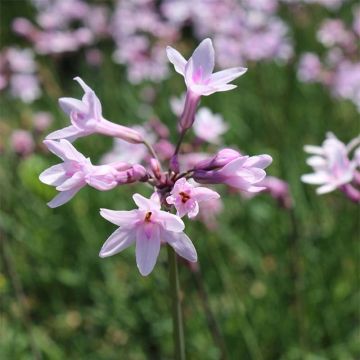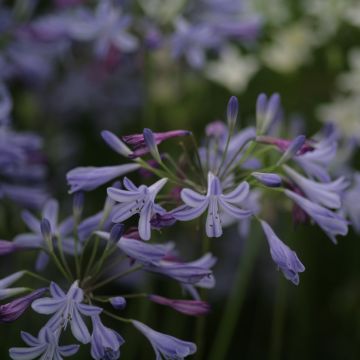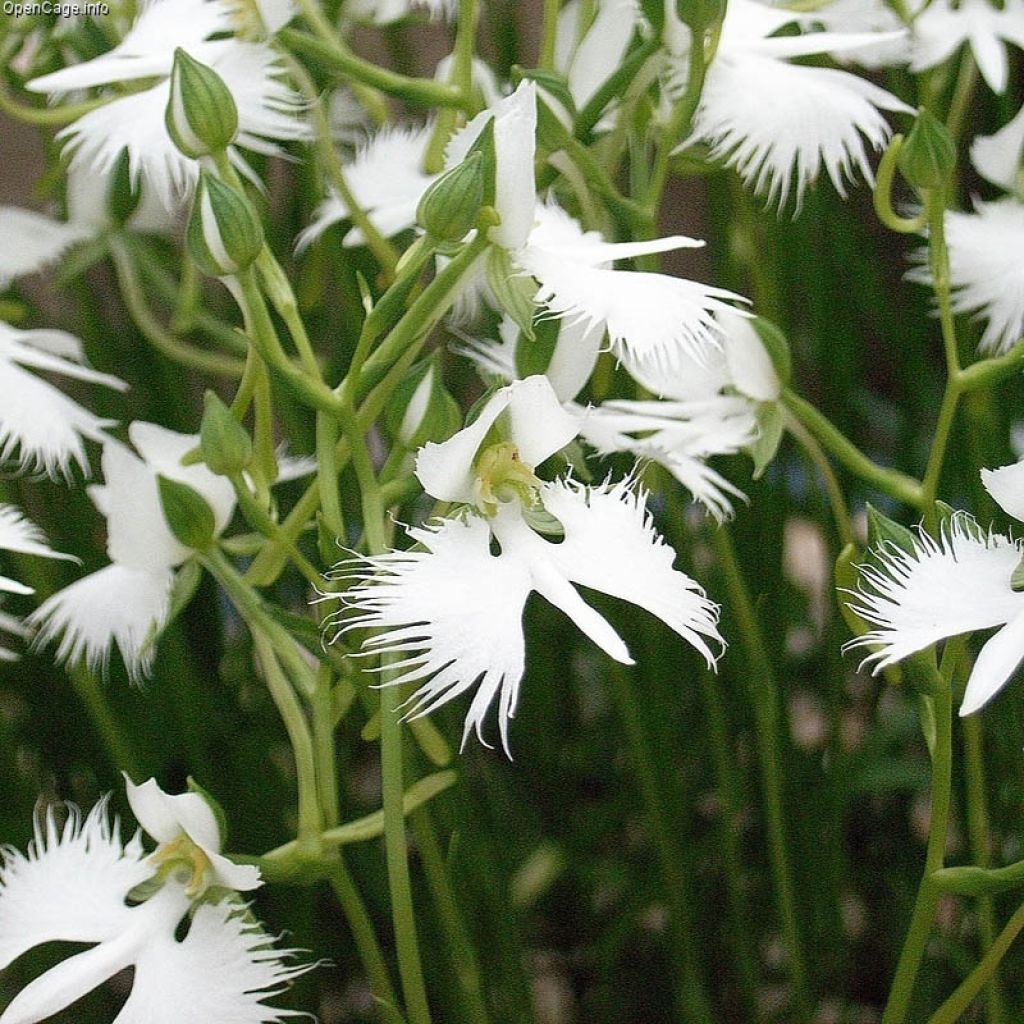

Habenaria radiata Variegata - Orchidée colombe panachée
Habenaria radiata Variegata
Habenaria radiata Variegata
White egret flower, Fringed orchid, Crane orchid
Why not try an alternative variety in stock?
View all →This plant carries a 6 months recovery warranty
More information
We guarantee the quality of our plants for a full growing cycle, and will replace at our expense any plant that fails to recover under normal climatic and planting conditions.
Does this plant fit my garden?
Set up your Plantfit profile →
Description
Habenaria radiata 'Variegata', known as Variegated Dove Orchid or Egret Orchid, is a rare terrestrial orchid native to Japan that surpasses anything that can exist in the vegetable kingdom. Its summer flowering closely imitates a cluster of doves, as each pure white flower blooms like a bird taking flight, with wings spread. The foliage of this form is variegated with green and white. Not content with being beautiful, the flowers are slightly fragrant. This bulbous plant requires light substrate, water, and a bright exposure. It cannot tolerate any frost. It is a dreamlike plant, but quite difficult to cultivate, which will delight discerning collectors in wonderful pots.
Habenaria radiata 'Variegata' belongs to the Orchidaceae family. It is native to eastern Asia, but it is also found in temperate areas of America and Africa, where it grows in marshy but permeable soils that dry out in autumn. It is a 'cold' orchid, meaning it is not tropical and its vital optimum temperature is between 12 and 16°C (53.6 and 60.8°F). Habenaria radiata produces clusters of 2 to 8 delicately fragrant small white flowers for about four weeks in summer. They measure barely 3cm (1in) in diameter but deserve to be observed up close. The silhouette of each one evokes a white bird taking flight, its fringed wings widely spread, hence the vernacular name of dove orchid. The floral stems can reach 25 to 30cm (10 to 12in) in height, or even more. The leaves are also small (5 to 20 cm (2 to 8in) long), narrow (1cm (0.4in) wide), and ribbon-like. They are shiny medium green edged with white, and grouped in a tuft at the base of the stalks. Individuals that are born completely white die before flowering due to a lack of photosynthesis. Once the flowering is over, the floral stem and leaves dry up. The tuber that allowed them to develop becomes desiccated, having developed very small filamentous tubers. These baby tubers mature in October, before entering a dormant period until spring. This plant is currently endangered in its natural habitat.
The Variegated Egret Orchid is mainly cultivated in pots. Like a collectible item, it deserves care and some attention that will allow it to bloom in our latitudes. Nowadays, Habenaria radiata is mainly found in turf moors in highlands at altitudes above 500m (1640ft). These areas are not, in most cases, suitable for rice cultivation, so this plant, along with many other rare species, has found refuge in the last wild strongholds of modern Japan.
Report an error about the product description
Plant habit
Flowering
Foliage
Botanical data
Habenaria
radiata
Variegata
Orchidaceae
White egret flower, Fringed orchid, Crane orchid
Southeast Asia
Other Summer bulbs A to Z
View all →Planting and care
The tubercles of Habenaria radiata 'Variegata' are very small. Plant them in a mixture of sphagnum and perlite or vermiculite (mostly sphagnum), or a mixture of light soil, sand, and gravel. The bulb should be placed vertically with the tip facing upwards and covered with 1cm (0.4in) of substrate. Water (only with osmosis water, rainwater or demineralised water) only when the sprout appears. From this stage, the substrate should never dry out until the plant starts to turn yellow in late summer, after flowering. Then, place the pot in a dry environment, with a humid atmosphere (the substrate remains dry), until spring. During the growing period, you can place the small pots in large containers filled with sphagnum, which have a water reserve that should be kept full, next to a source of light (bay window, large window, or outside). During the resting period, remove the pots from the turf moor and place them nearby where the ambient air remains humid. Habenaria radiata needs a sunny location to thrive. It does well on a patio or in a greenhouse. As it is very susceptible to rot, it requires light and regular watering during growth, while avoiding excess water, like all orchids. Tubercle repotting should be done at the end of the resting periods, in late winter.
Planting period
Intended location
Care
-
, onOrder confirmed
Reply from on Promesse de fleurs
Similar products
Haven't found what you were looking for?
Hardiness is the lowest winter temperature a plant can endure without suffering serious damage or even dying. However, hardiness is affected by location (a sheltered area, such as a patio), protection (winter cover) and soil type (hardiness is improved by well-drained soil).

Photo Sharing Terms & Conditions
In order to encourage gardeners to interact and share their experiences, Promesse de fleurs offers various media enabling content to be uploaded onto its Site - in particular via the ‘Photo sharing’ module.
The User agrees to refrain from:
- Posting any content that is illegal, prejudicial, insulting, racist, inciteful to hatred, revisionist, contrary to public decency, that infringes on privacy or on the privacy rights of third parties, in particular the publicity rights of persons and goods, intellectual property rights, or the right to privacy.
- Submitting content on behalf of a third party;
- Impersonate the identity of a third party and/or publish any personal information about a third party;
In general, the User undertakes to refrain from any unethical behaviour.
All Content (in particular text, comments, files, images, photos, videos, creative works, etc.), which may be subject to property or intellectual property rights, image or other private rights, shall remain the property of the User, subject to the limited rights granted by the terms of the licence granted by Promesse de fleurs as stated below. Users are at liberty to publish or not to publish such Content on the Site, notably via the ‘Photo Sharing’ facility, and accept that this Content shall be made public and freely accessible, notably on the Internet.
Users further acknowledge, undertake to have ,and guarantee that they hold all necessary rights and permissions to publish such material on the Site, in particular with regard to the legislation in force pertaining to any privacy, property, intellectual property, image, or contractual rights, or rights of any other nature. By publishing such Content on the Site, Users acknowledge accepting full liability as publishers of the Content within the meaning of the law, and grant Promesse de fleurs, free of charge, an inclusive, worldwide licence for the said Content for the entire duration of its publication, including all reproduction, representation, up/downloading, displaying, performing, transmission, and storage rights.
Users also grant permission for their name to be linked to the Content and accept that this link may not always be made available.
By engaging in posting material, Users consent to their Content becoming automatically accessible on the Internet, in particular on other sites and/or blogs and/or web pages of the Promesse de fleurs site, including in particular social pages and the Promesse de fleurs catalogue.
Users may secure the removal of entrusted content free of charge by issuing a simple request via our contact form.
The flowering period indicated on our website applies to countries and regions located in USDA zone 8 (France, the United Kingdom, Ireland, the Netherlands, etc.)
It will vary according to where you live:
- In zones 9 to 10 (Italy, Spain, Greece, etc.), flowering will occur about 2 to 4 weeks earlier.
- In zones 6 to 7 (Germany, Poland, Slovenia, and lower mountainous regions), flowering will be delayed by 2 to 3 weeks.
- In zone 5 (Central Europe, Scandinavia), blooming will be delayed by 3 to 5 weeks.
In temperate climates, pruning of spring-flowering shrubs (forsythia, spireas, etc.) should be done just after flowering.
Pruning of summer-flowering shrubs (Indian Lilac, Perovskia, etc.) can be done in winter or spring.
In cold regions as well as with frost-sensitive plants, avoid pruning too early when severe frosts may still occur.
The planting period indicated on our website applies to countries and regions located in USDA zone 8 (France, United Kingdom, Ireland, Netherlands).
It will vary according to where you live:
- In Mediterranean zones (Marseille, Madrid, Milan, etc.), autumn and winter are the best planting periods.
- In continental zones (Strasbourg, Munich, Vienna, etc.), delay planting by 2 to 3 weeks in spring and bring it forward by 2 to 4 weeks in autumn.
- In mountainous regions (the Alps, Pyrenees, Carpathians, etc.), it is best to plant in late spring (May-June) or late summer (August-September).
The harvesting period indicated on our website applies to countries and regions in USDA zone 8 (France, England, Ireland, the Netherlands).
In colder areas (Scandinavia, Poland, Austria...) fruit and vegetable harvests are likely to be delayed by 3-4 weeks.
In warmer areas (Italy, Spain, Greece, etc.), harvesting will probably take place earlier, depending on weather conditions.
The sowing periods indicated on our website apply to countries and regions within USDA Zone 8 (France, UK, Ireland, Netherlands).
In colder areas (Scandinavia, Poland, Austria...), delay any outdoor sowing by 3-4 weeks, or sow under glass.
In warmer climes (Italy, Spain, Greece, etc.), bring outdoor sowing forward by a few weeks.



































